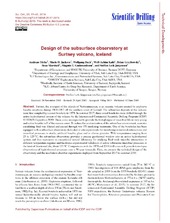| dc.contributor.author | Türke, Andreas | |
| dc.contributor.author | Jackson, Marie D | |
| dc.contributor.author | Bach, Wolfgang | |
| dc.contributor.author | Kahl, Wolf-Achim | |
| dc.contributor.author | Grzybowski, Brian | |
| dc.contributor.author | Marshall, Beau | |
| dc.contributor.author | Gudmundsson, Magnus T. | |
| dc.contributor.author | Jørgensen, Steffen Leth | |
| dc.date.accessioned | 2020-05-29T11:58:05Z | |
| dc.date.available | 2020-05-29T11:58:05Z | |
| dc.date.issued | 2019-06-12 | |
| dc.Published | Türke A, Jackson, Bach W, Kahl, Grzybowski, Marshall, Gudmundsson MT, Jørgensen SL. Design of the subsurface observatory at Surtsey volcano, Iceland. Scientific Drilling. 2019;25:57-62 | eng |
| dc.identifier.issn | 1816-8957 | en_US |
| dc.identifier.issn | 1816-3459 | en_US |
| dc.identifier.uri | https://hdl.handle.net/1956/22412 | |
| dc.description.abstract | Surtsey, the youngest of the islands of Vestmannaeyjar, is an oceanic volcano created by explosive basaltic eruptions during 1963–1967 off the southern coast of Iceland. The subsurface deposits of the volcano were first sampled by a cored borehole in 1979. In summer 2017, three cored boreholes were drilled through the active hydrothermal system of the volcano by the International Continental Scientific Drilling Program (ICDP) SUSTAIN Expedition 5059. These cores are expected to provide the first glimpse of microbial life in very young and native basaltic tuff of the oceanic crust. To reduce the contamination of the subsurface environment, seawater circulating fluid was filtered and passed through two UV-sterilizing treatments. One of the boreholes has been equipped with a subsurface observatory dedicated in situ experiments for monitoring water–rock interactions and microbial processes in sterile, artificial basaltic glass and in olivine granules. With temperatures ranging from 25 to 125 ∘C, the subsurface observatory provides a precise geothermal window into an active hydrothermal system and thus represents an exceptional natural laboratory for studying fluid–rock–microbe interactions at different temperature regimes and facilitates experimental validation of active submarine microbial processes at the limit of functional life, about 121 ∘C. Comparisons with the 1979 and 2019 drill cores will provide time-lapse observations of hydrothermal processes over a 50-year timescale. Here, we present the technical design of the observatory and the incubation chamber experiments deployed from September 2017 to summer 2019. | en_US |
| dc.language.iso | eng | eng |
| dc.publisher | Copernicus | en_US |
| dc.rights | Attribution CC BY | eng |
| dc.rights.uri | http://creativecommons.org/licenses/by/4.0/ | eng |
| dc.title | Design of the subsurface observatory at Surtsey volcano, Iceland | en_US |
| dc.type | Peer reviewed | |
| dc.type | Journal article | |
| dc.date.updated | 2020-02-18T15:14:58Z | |
| dc.description.version | publishedVersion | en_US |
| dc.rights.holder | Copyright © The Authors 2019 | en_US |
| dc.identifier.doi | https://doi.org/10.5194/sd-25-57-2019 | |
| dc.identifier.cristin | 1714800 | |
| dc.source.journal | Scientific Drilling | |

